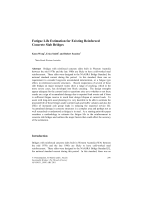Bridges

- Publication no: ABC-IAR004-11
- Published: 31 October 2011
- PDF (free) Download
Bridges with reinforced concrete slabs built in Western Australia between the mid 1970s and the late 1980s are likely to have cold-worked steel reinforcement. These slabs were designed to the NAASRA Bridge Standard, the national standard current during this period. In this standard, there was no requirement to consider long-term accumulated deterioration, or a fatigue type effect, in reinforced concrete structures. Recent inspections of several of these slab bridges on major transport routes show a range of cracking, which in the more severe cases, has developed into block cracking. The design strengths appear adequate for the current loads so questions arise as to whether or not these cracks are a sign of accumulated damage due to repeated load events and if there is sufficient fatigue reserve to reach their design lifespan at current loads. To assist with long-term asset planning it is very desirable to be able to estimate the projected life of these bridges under current loads and traffic volumes and also the effect of increased axle group loads in reducing the expected service life. Accumulated damage in concrete structures is a complex area and perhaps not as well researched or understood as fatigue is in steel. As a starting point this paper considers a methodology to estimate the fatigue life in the reinforcement in concrete slab bridges and outlines the major factors that could affect the accuracy of the estimation.
